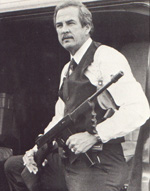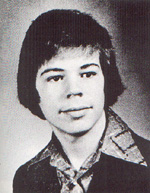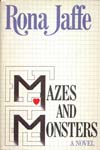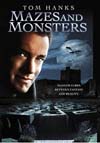
|

|
Main > FAQs > The Gaming Advocacy Encyclopedia
The Gaming Advocacy Encyclopedia In most any discussion about gaming advocacy, many names will be thrown around without any explanation as to their involvement in the big picture. The purpose of this page is to give a point of reference for many of those names. Entries
are being added constantly. If you find that a topic is
incorrect, needs clarification, or isn't listed at all, please let me
know -
Acronym
for Bothered About Dungeons & Dragons, a
group founded by Patricia Pulling
after the suicide of her son Irving
Pulling. BADD sought, among other things, to remove
role-playing games from all schools, and put suicide warning
labels on their covers.
Bellevue,
Washington youth who, along with his best friend, David
Anderson, murdered 20-year-old Kim Wilson on January 3rd,
1997, then went to her home and murdered the rest of her
family.
Despite the media's attempts to attach the crime to Dungeons
& Dragons, Baranyi stated that his actions had
nothing to do with the game... and that he had not played for several
years prior to the murder. Baranyi was found guilty.
Acronym for the Committee for the Advancement of Role-Playing Games, a group formed in December 1987 in reaction to Geraldo Rivera´s "Games That Kill" report. This report aired on Entertainment Tonight, October 12th & 13th, 1987. For more information on the CAR-PGa, visit www.theescapist.com/carpga.htm
Madison, Ohio youth who died on April 28th, 1983 during an attempt at auto-erotic asphyxiation. BADD has attempted to associate this youth's death with D&D, despite the fact that this particular activity and the game have nothing in common. They also list his death as a suicide, which is an obvious error - his death was an accident.
A televised miniseries that aired on NBC, May 17th and 19th, 1992. It was based on a Joe McGinniss novel of the same name that detailed the murder of Leith Von Stein. In it, a copy of TSR's AD&D Player's Handbook was featured as a prop with altered pages, making the book appear to be more of an inspiration to the crime. According to accounts of the film, the book was embellished with different artwork to feature a picture of a character with clothing and a backpack that matched that of one of the show's killers, as well as other illustrations that were extremely occultic and sinister in nature. Another
made-for-TV movie, Honor
Thy Mother, was based on the same story, and also
falsified facts about D&D to more closely
connect the crime with the game.
Private investigator who wrote The Dungeon Master, the story of his investigation into the disappearance of James Dallas Egbert III. Dear's actions during his investigation began the anti-gaming movement. In order to protect the social status of Egbert's family, he kept the real reasons behind the disappearance a secret, and led the public to believe that both it and the suicide were caused by D&D. It is interesting to note that Dear changed the selling strategy for his book, shifting it's advertising focus from D&D to drugs, as sales of the book began to dwindle.
Lynnwood, Washington youth who committed suicide on May 19th, 1981. His father, a former police officer, claims that he saw Michael summoning D&D demons moments before killing himself, and that he could smell the odor of sulfur and garlic in his son's room after his death. These odors, according to the father, are commonly associated with a demonic summoning. Very few facts are known about this incident, as the only record available is the testament of Dempsey's father, who is obviously against the game. However, the following things are wrong with that testimony:
College
student whose story became the first gaming-related urban legend.
Egbert, a manic depressive, hid in the steam tunnels beneath his
college campus to kill himself with an overdose of drugs, not to play
any form of RPG. This act spawned the oft-heard legend that gamers play
their games in steam tunnels, sewers, and abandoned mines and caves.
One year after the incident, and even longer since he had last played D&D,
Egbert killed himself with a handgun. Egbert's story was chronicled in The
Dungeon Master, a book by investigator William Dear. For a
more detailed account of the Egbert case, please visit the Basic Gaming Advocacy
FAQ.
(Note: of all the sources available on this case, none of them agree on the spelling of the younger Erwin brother's name. In the interest of reducing confusion, the former spelling will be used here.) Lafayette, Colorado brothers who committed murder/suicide in November of 1984. Daniel, was 16, and Steven was 12. Daniel forced his younger brother to shoot him and then Steven turned the gun on himself. BADD and other anti-game groups and individuals have often attempted to connect this tragedy to gaming - despite the absolute lack of evidence to that end, and weighty evidence to the contrary. Daniel had pled guilty to auto theft previously, and was facing sentencing within a month. He was described as being "extremely afraid of the criminal justice system," and did not want to return to the school, which would have been part of his deferred sentence. The parents of both boys have always maintained that games had nothing to do with the suicide - even Lafayette Police Chief Larry Stallcup admitted initially that the game had no connection. Stallcup reversed his story later, however, and stated that he had been "threatened" by TSR into changing his position. This "threat" was actually a request from TSR for a written statement that "investigation and news sources will be fair and careful when making any references to our products." This was hardly anything more than a reasonable request for common sense - and certainly not something that a Police Chief should have been scared of. When CBS's 60 Minutes ran an anti-game story on September 15th, 1985, and covered the Erwin suicides, the parents of the two boys became enraged. They spoke out against the misrepresentation, but neither CBS nor 60 Minutes have ever issued a retraction.
Pennsylvania
youth who, in 1995, took the lives of a young mother and her baby.
After a thorough search of his home, police found a collection of AD&D
and Vampire books, as well as a collection of Magic
cards. The anti-gaming media focus was on Vampire,
despite the fact that Fairley's crime had no 'vampiric' elements
whatsoever. At the murder trial, a Vampire
t-shirt was submitted as evidence, despite the fact that Fairley wasn't
wearing it when he committed the crime; newspaper accounts mention a
bloody paisley-patterned shirt that was worn during the act.
Teen
who believed he was a vampire, started a "vampire clan," and murdered
the parents of Heather Wendorf, one of his "clan members," in November
of 1996. The media swarmed over the vampire angle of the
story, despite the fact that the Wendorf's bodies showed "no sign of
vampiric activity"; both were bludgeoned to death, and neither had been
drained of any blood. An "occult marking" found on both of
the bodies turned out to be a letter "V" with seven marks around it,
one for each of the clan members. Ferrell was sentenced to
death in early 1999.
Wife
of former vice president Al Gore and founder of the Parent's Musical
Resource Center (PMRC), a watchdog group for popular
music. In her book Raising PG Kids In An
X-Rated World, she lists D&D as
one of the many occultic fads in which teens of the day have involved
themselves. The book also listed contact information for BADD and Pat
Pulling.
A novel written by John Coyne in the shadow of Mazes and Monsters. Previously, I had a rather inaccurate synopsis of the book posted here, which was based on my memory of reading it almost 20 years ago. A couple of Escapist readers have set me straight, however, and Bryce Alan Katz sent me this new and improved synopsis, which he graciously allowed me to reprint here: Though
gaming in general is still primarily portrayed in a negative light, it
does get a little positive spin in one or two places. Coyne describes
the gaming group in the main character's former (private boys') school
as a relatively popular social club led by a member of the faculty.
It's only after the boy moves away from this support group following
the untimely death of his father that gaming takes on a negative
light.
However, this too is given in what I felt was a fair context. Coyne, in my opinion, took time to play up the mental instability of the main character before things went to hell. Scott Gardner (the main character) had a VERY hard time dealing with his father's death, the shock of leaving his social supports (his friends and gaming group), and trying to find a place in a small town public school where the negative opinion of roleplaying games was prevalent. Instead of dealing with these problems, he withdrew into the fantasy world of Hobgoblin. The story focuses on the game as an enabler that helped Scott slip into insanity. It did NOT focus on gaming as the CAUSE. (It) was not cast directly in the role of a villain, only as a comforting framework that gave an unstable mind something to cling to amid the whirling ruin of his life. Others' opinions may be found at Amazon.com (Link)
A made-for-television movie based on the book Blood Games by Jerry Bledsoe, and focusing on the murder of Lieth Von Stien by his stepson. The movie aired on CBS (the same network that brought us Mazes and Monsters), April 26th, 1992, and starred Sharon Gless. In it, a "phony" copy an AD&D manual was featured as a prop. The cover of the manual was unlike anything TSR has ever put out for AD&D, and while reading it, an investigator claims to find a reference to "extra points for multiple hits," an obvious fabrication by the writers, as AD&D contains no rules that are even similar to such a description. This was an attempt to draw a clearer link between the crime and the game, in the typical sensationalist fashion. This
story was also covered in Cruel
Doubt, another made-for-TV movie (a miniseries,
aired on NBC) that also tried to make the
connection by misrepresenting a real game.
NBC
television series starring Christina Applegate as a single mother
attempting to get her G.E.D. In an episode that aired in
February of 1999, Jesse goes out on a date with her math teacher to an
"exclusive club." As it turns out, the teacher is
an avid D&D player, and has brought her
to a gaming club meeting. The ten-minute segment pokes a
lot of fun at gamers, but leaves out any references to
Satanism, witchcraft, or the occult. (The best
part: when Jesse calls a friend to tell her she's at a D&D
game, the friend yells "Oh crap! Get out of there!")
A novel by Rona Jaffe, later turned into a made-for-TV movie starring Tom Hanks. The TV adaptation was aired on CBS on December 28th, 1982. In the movie, a bright young college student (Hanks) loses his hold on reality while playing a role-playing game. Gaming is depicted as an obsessive hobby, played, for the most part, by social outcasts. One of the most humorous scenes of the film happens when Jay Jay's character jumps into a pit to collect what he thinks is treasure, only to find it filled with sharp spikes. "Why didn't you use your sonar?" chides another player (Sonar? Were they playing dolphins?). Released to video as "Dungeons And Dragons" (!) in the late 80's by Film Ventures. Recently, I found a copy (with the original title, by Front Row Entertainment) in the budget video rack of my local Suncoast Video. Both videos, for obvious reasons, have Hanks' face plastered on the cover. Added
note on the novel: A fictional letter to the editor that introduces the
book was quoted as real and factual by Dr. Thomas Radecki in an attempt
to indemnify RPGs.
Pacific Grove, CA youth who was stabbed and beaten to death in 1997 while taking photographs at a recreation trail. Olinger's mother, Shell Phillips, was convinced that the crime was perpetrated by local gamers who congregated in that area with her son before his death, and urged police to investigate that possibility. In 2006, police were able to identify a suspect from a palm print lifted from Olinger's car, and announced two suspects and their motive - carjacking and robbery. Phillips never lived to know the truth - she passed away in 2003 at the age of 48.
Son of Patricia Pulling, founder of Bothered About Dungeons & Dragons (B.A.D.D.). Pulling committed suicide with his mother's revolver not long after returning home from school on June 9th, 1982. His mother was quick to blame his suicide on a D&D session that occurred that day in which his character allegedly received a curse. None of the other players present at the game remember such a curse. Pulling
faced a lot of problems that could have been contributing factors: he
had troubles fitting in at school and couldn't find a running partner
in his bid for school office, and was known to have written "Life is a
joke" on a school blackboard not long before his suicide. Weeks before
his death, nineteen rabbits that he had been raising and a house cat
were found disemboweled.
Mother of Irving "Bink" Pulling and founder of Bothered About Dungeons & Dragons (B.A.D.D.). Pulling was infamous for her selective reporting techniques; that is, when displaying an article from a newspaper or magazine, she would remove sections of text that did not agree with her point of view and shift the order of the paragraphs in the article. This would often alter the original intention of the article drastically. After
the suicide of her son, Pulling devoted her life to spreading the word
of the imagined evils behind gaming. In this time, she founded
B.A.D.D., sued (and lost against) Bink's school and TSR for wrongful
death, and solicited the Surgeon General to put a warning label on D&D,
claiming that it could cause its players to commit suicide.
She also wrote "Interviewing Techniques For Adolescents," a primer for
police officers who are dealing with crimes that involve role-playing
games. In it, she lists ESP (extra sensory perception) as a
occultic ability, despite the fact that she claimed to have had a
premonition of Bink's death as she approached her house the day of his
suicide. Pulling died of cancer in October of 1997.
Founder
of NCTV (National Coalition for Television Violence) and board member
on Tipper Gore's PMRC
group who once used quoted material from Rona Jaffe's novel Mazes & Monsters
as if it was real and factual. Radecki, a psychologist, lost
his license to practice for five years for engaging in immoral conduct
with a patient. He has since returned to his practice.
Murderer
who killed a convenience store clerk in 1985, and his parents in
1986. Sellers' attorneys tried several defenses to avoid the
death penalty; the classic "D&D made me do
it" defense, the Satanism defense, and later, the Multiple Personality
Disorder defense. All of them failed.
Sellers was executed in February of 1999. He was the first
person executed for a crime committed at the age of 16 in the last
forty years.
One of the most requested nuggets of information here at The Escapist - "Where can I find that report where the guy proves that D&D actually prevents suicide?" is how the query usually goes. I've
nicknamed it The Suicide Statistic Fallacy, and it comes from Michael
Stackpole's 1989 document Game Hysteria and the Truth.
The statement that Stackpole makes does not go so far as to suggest
that gamers are any less likely to kill themselves than non-gamers -
rather, it demonstrates the useless and arbitrary statistics that are
favored by anti-gamers, and uses them to disprove their own cause:
It's also interesting to note that Stackpole mentions how the suicide began to fall after 1980 and continued to fall through the rest of the 80s, which was the same time that the popularity of Dungeons & Dragons began to soar. It
bears repeating: This should not, in any way, be taken as a
scientific study that gamers are less likely to kill themselves or
others. Such studies may exist, but this is not
one of them. Some of the numbers used here are from Pulling
herself, and are far from accurate. Her claim of 125
gaming-related crimes is questionable, considering that she never
supplied anyone with a complete list, but instead relied on claims of
unpublicized and confidential cases that no one can verify.
The primary point here is that if she really wanted to use arbitrary
numbers to prove that games cause people to kill, she should have set
those numbers much higher in order to break the national averages.
Popular
Fox television show that has had its share of D&D
references... usually in good taste. Langley, one of the
members of Mulder's contact group The Lone Gunmen, is a gamer, and a
couple of episodes have depicted him and some friends playing D&D
for money (how exactly is this done?). In one of the best
episodes of the series, "Josie Chung's From Outer Space,"
a UFO fanatic tells Chung: "I didn't play Dungeons &
Dragons for all those years and not learn something about
courage."
This document is a work in progress, and is in no way complete as you see it here. If I have left something out, or missed an important point, it is imperative that you, the reader, bring it to my attention. All contributors will receive credit for their contributions at the end of the document. You can learn more about role-playing games by exploring the other FAQ files in this section:
|







